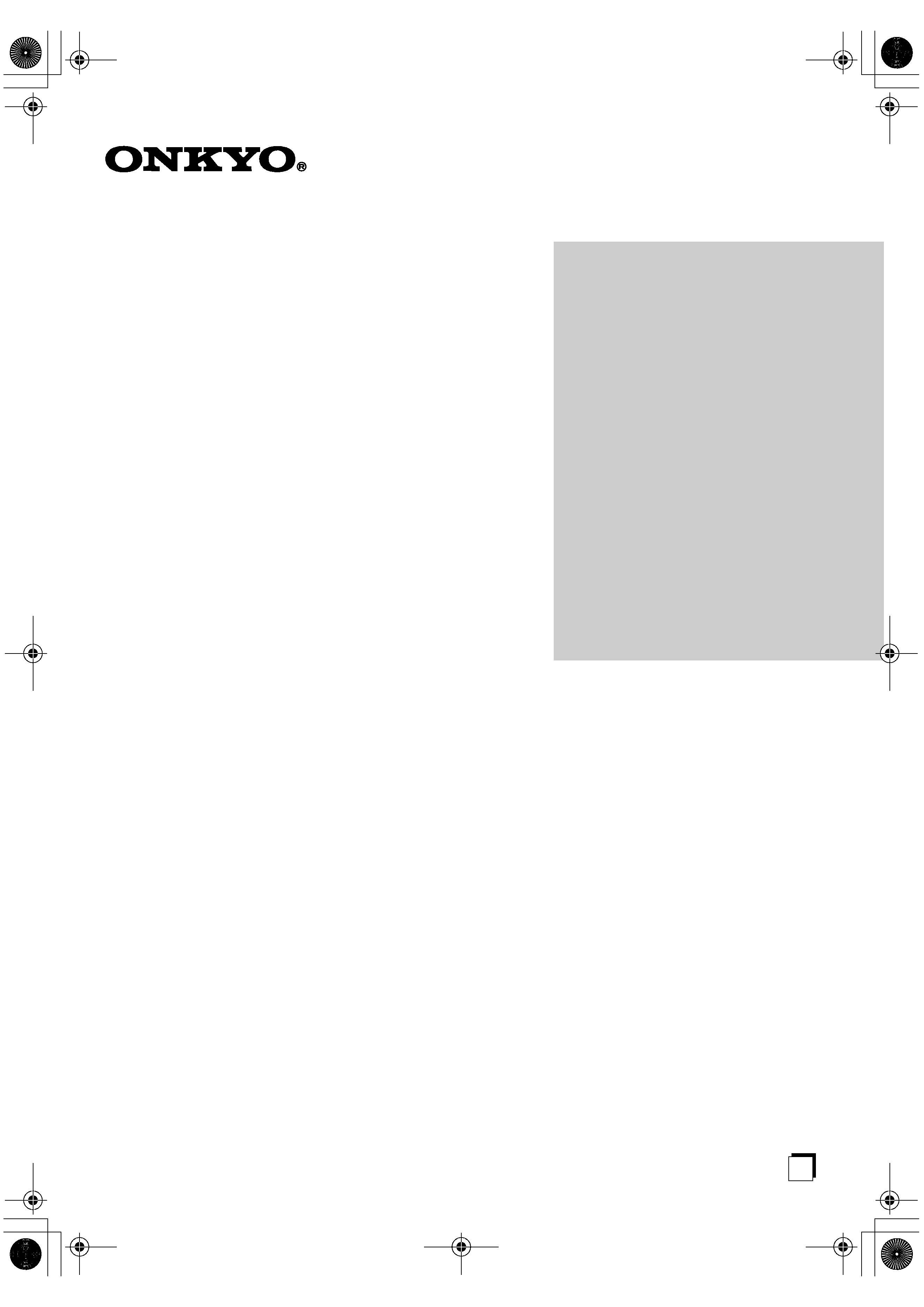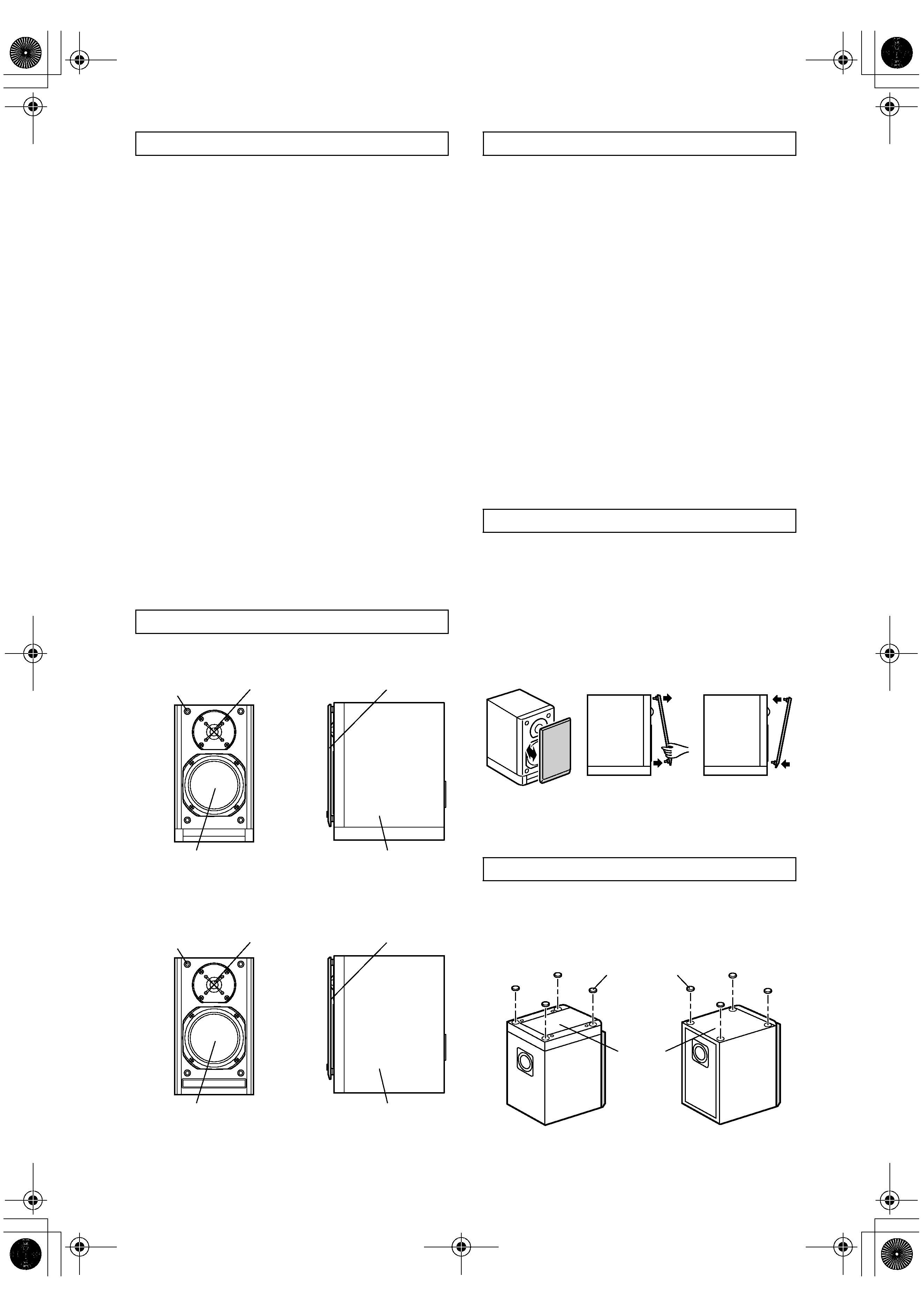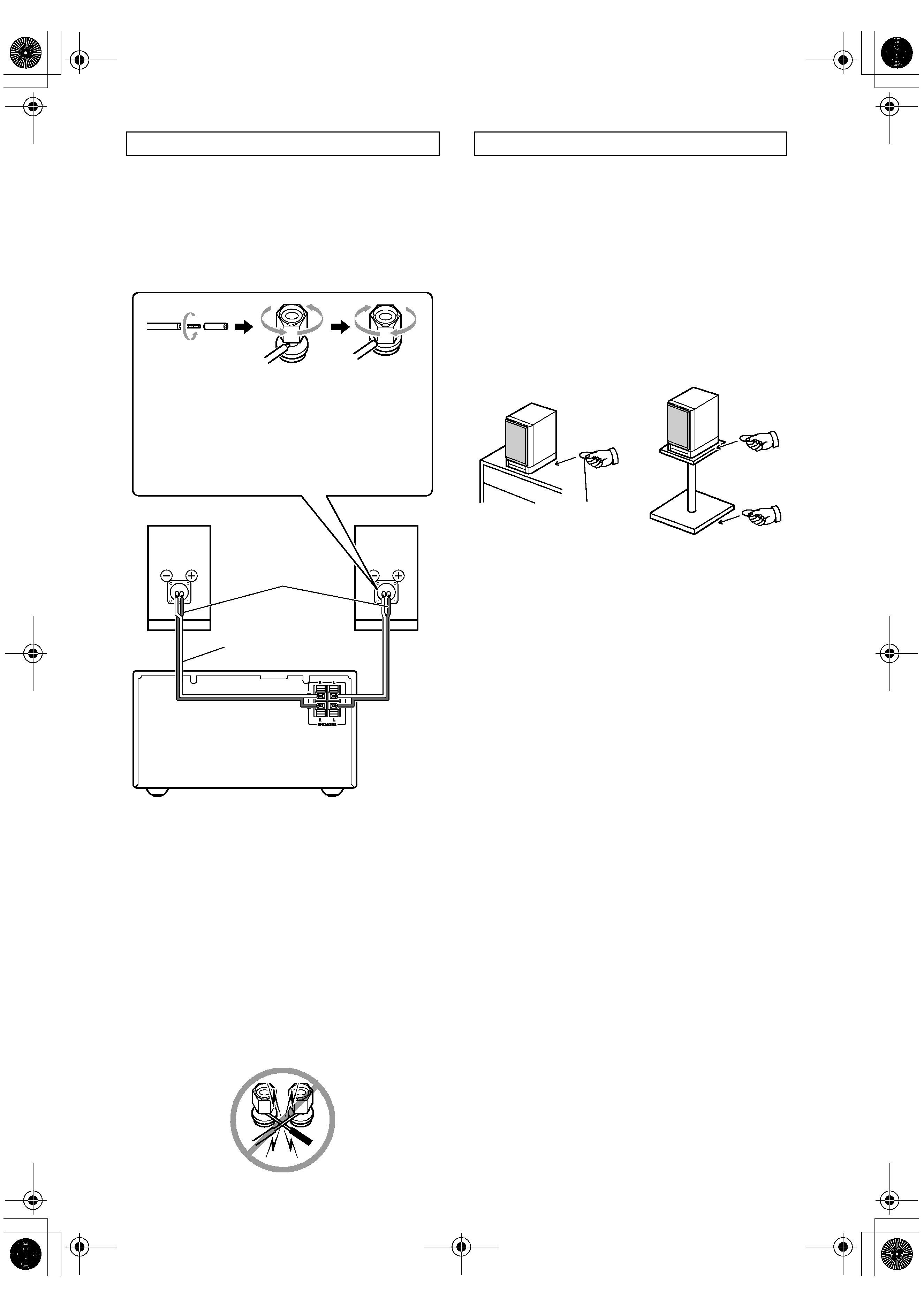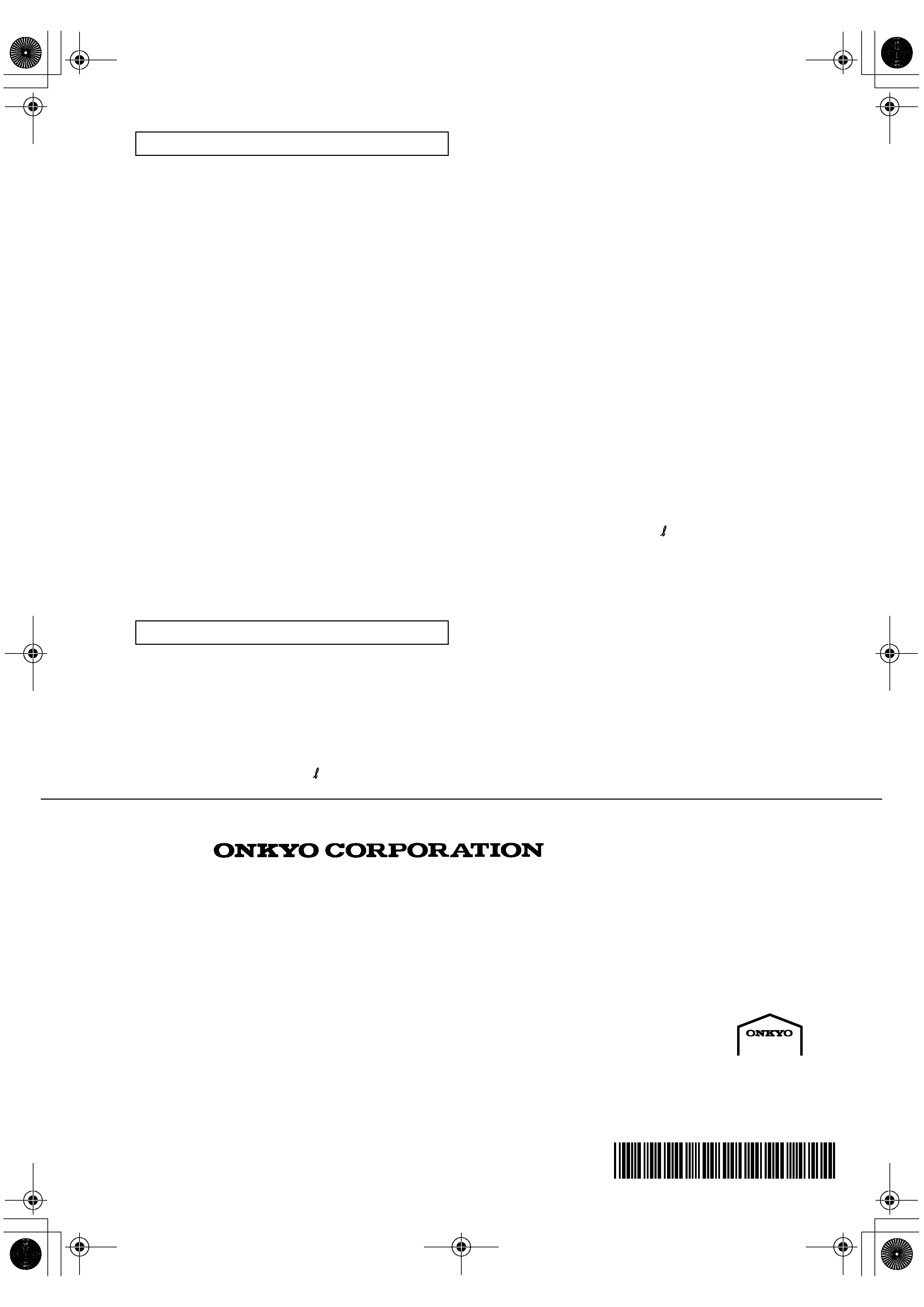
En
Speaker System
D-N10BX
D-N9BX
D-N7BX
Instruction Manual
Thank you for purchasing an Onkyo Speaker
System.
Please read this manual thoroughly before using
it. Following the instructions in this manual will
enable you to obtain optimum performance and
listening enjoyment from your new Speaker Sys-
tem.
Please retain this manual for future reference.
Before UsingYour New Speakers
· The speaker cabinets are made out of
wood and are therefore sensitive to
extreme temperatures and humidity.
Do not use them in locations subject to
direct sunlight or in humid places,
such as near an air conditioner, humid-
ifier, bathroom, or kitchen.
· Place the speakers on sturdy, flat sur-
faces. Putting them on uneven or
unstable surfaces where they may fall
and cause damage will affect the
sound quality.
· Do not keep water or other liquids
close to the speakers. If a liquid is
spilled over them, the woofer and
tweeter inside may be damaged.
· Do not handle the speakers with wet or
damp hands.
D-N10BX,N9BX,N7BX_En.fm Page 1 Friday, June 30, 2006 11:26 AM

2
In catalogs and on packaging, the letter at the end of the
product name indicates the color. Specifications and
operation are the same regardless of the color.
The speakers can handle the specified input power when
used for normal music reproduction. If they're fed any
of the following signals, even if the input power is
within the specified rating, excessive current may flow
in the speaker coils, causing burning or wire breakage:
1. Interstation noise from an untuned FM radio.
2. Audio from a cassette that's being fast-forwarded.
3. High-pitched sounds generated by an oscillator, elec-
tronic musical instrument, and so on.
4. Amplifier oscillation.
5. Special test tones from audio test CDs and so on.
6. Thumps and clicks caused by connecting or discon-
necting audio cables (always turn off your amplifier
before connecting or disconnecting cables).
7. Microphone feedback.
The speakers contain powerful magnets. Do not put
metal items, such as screwdrivers, close to the speakers,
as they may be attracted toward the magnet, causing
injury, or damage to the tweeter diaphragm.
· D-N10BX/D-N9BX
· D-N7BX
The two speakers are identical, so it doesn't matter
which one you use on the left or right.
TVs and computer monitors are magnetically sensitive
devices and as such are likely to suffer from discolora-
tion or picture distortion when conventional speakers
are placed nearby. To prevent this, the speakers feature
internal magnetic shielding. In some situations, how-
ever, discoloration may still be an issue. In this case,
turn off your TV or monitor, wait 15 to 30 minutes, and
then turn it back on again. This normally activates the
degaussing function, which neutralizes the magnetic
field, thereby removing any discoloration effects. If dis-
coloration problems persist, try moving the speakers
away from your TV or monitor. Note that discoloration
can also be caused by a magnet or demagnetizing tool
that's too close to your TV or monitor.
Note:
If the speakers are placed close to a TV or monitor, due
to the electromagnetic waves radiated by the TV or
monitor, you may hear noise from the speakers even
after your amplifier has been turned off. To prevent this,
position the speakers away from your TV or monitor.
You can use the speakers either with or without their
grilles, which can be removed as follows.
1. Use both hands to gently pull the bottom of the grille
away from the speaker.
2. Use both hands to gently pull the top of the grille
away from the speaker.
3. To replace the grille, align the four fasteners and gen-
tly push the grille toward the speaker.
* D-N10BX/D-N9BX shown here. Grille removal is
the same for the D-N7BX.
You can improve the sound quality by attaching the
included cork spacers to raise the speakers off the surface
and reduce the contact area. The cork spacers also make
the speakers stable and prevent them from slipping.
* D-N10BX shown here.
Precautions
Getting to Know the Speakers
Tweeter
Grille
Woofer
Cabinet
Grille attach-
ment catcher
Tweeter
Grille
Woofer
Cabinet
Grille attach-
ment catcher
Using Close to a TV or Computer
Removing the Speaker Grilles
Using the Included Cork Spacers
Replace
Remove
D-N10BX/D-N9BX
D-N7BX
Cork spacer
Bottom
D-N10BX,N9BX,N7BX_En.fm Page 2 Friday, June 30, 2006 11:26 AM

3
· Before connecting the speakers, disconnect your
amplifier's power cord from the wall outlet and set its
volume control to minimum.
· The speaker's rated impedance is 4
. Make sure you con-
nect an amplifier that is compatible with a 4
impedance.
· Use the supplied speaker cables to connect the speak-
ers to your amplifier as shown.
The type of speaker terminals used on the receiver and
their position depends on the model. Refer to the
receiver's instruction manual for details on connecting
speakers to the receiver.
Before Turning on Your Receiver:
· Make sure the speaker's positive (+) terminals are
connected to the amplifier's positive (+) terminals,
and the speaker's negative () terminals are con-
nected to the amplifier's negative () terminals. If you
get the polarity reversed, the sound will be unnatural,
with a limited bass range and poor stereo image.
· Make sure that the positive (+) and negative () wires
are not touching each other. If they are, a short circuit
may occur, damaging your amplifier.
The sound quality of the speakers is directly affected by
the size and shape of the room they're used in and its
furnishings. When considering where to place your
speakers, read the following:
· Where possible, mount the speakers on speaker
stands, concrete blocks, bricks, or a sturdy bookshelf.
Putting them directly on the floor will emphasize bass
sounds, creating a boomy sound.
· If a speaker is placed on an uneven surface where it
can wobble or vibrate, bass performance will be
adversely affected. You can eliminate speaker wobble
by putting a shim made out of cork or metal, such as a
coin, underneath the speaker or stand, as shown.
· If you mount the speakers on a flat surface, such as a
bookshelf, you can improve the sound quality by
inserting cork spacers or coins in between the speaker
and the shelf. Raising them off the surface like this
will reduce the contact area and improve the sound.
· If you like lots of bass, mount the speakers on low
speaker stands and place them in front of a solid wall.
·Walls and furnishings affect sound quality. To achieve
a good stereo sound, put the left and right speakers in
similar locations at the same distance away from your
listening position and at the same height. If you put
them in totally different locations, for example, one
on the floor and the other on a bookshelf, the stereo
imaging will be adversely affected.
·To determine the best positions for your speakers,
imagine an equilateral triangle and put the left and
right speakers at the ends of the base. The ideal listen-
ing position is at or slightly behind the triangle's
apex. Angle the speakers toward your listening posi-
tion.
· Glass doors and smooth walls behind the listening
position can reflect the sound from the speakers and
can make sounds at certain frequencies louder. You
can prevent this by hanging sound-absorbing mate-
rial, such as thick curtain, on the door or wall.
D-N10BX
· Please note that the speakers' surface features a spe-
cial finish. An object placed on the speakers for a
long period of time may leave a trace or mark. Adhe-
sive tape may also leave a mark.
Connecting the Speakers
Right speaker
Left speaker
Speaker cable
Positive (+) side is
indicated by a
red line
D-N10BX
shown
1.Peel the
insulation off
the ends of
the speaker
cable and
twist the
core wires.
2.Loosen the
terminal screw
and insert the
speaker cable
into the hole
(until the core
wires are
inserted fully).
3.Fasten the
terminal
screw.
Speaker Placement
Shim
D-N10BX,N9BX,N7BX_En.fm Page 3 Friday, June 30, 2006 11:26 AM

4
SN 29344283B
I0607-3
(C) Copyright 2006 ONKYO CORPORATION Japan. All rights reserved.
http://www.onkyo.com/
HOMEPAGE
Sales & Product Planning Div. : 2-1, Nisshin-cho, Neyagawa-shi, OSAKA 572-8540, JAPAN
Tel: 072-831-8023 Fax: 072-831-8124
ONKYO U.S.A. CORPORATION
18 Park Way, Upper Saddle River, N.J. 07458, U.S.A.
Tel: 201-785-2600 Fax: 201-785-2650 http://www.us.onkyo.com/
ONKYO EUROPE ELECTRONICS GmbH
Liegnitzerstrasse 6, 82194 Groebenzell, GERMANY
Tel: +49-8142-4401-0 Fax: +49-8142-4401-555 http://www.eu.onkyo.com/
ONKYO EUROPE UK Office
Suite 1, Gregories Court, Gregories Road, Beaconsfield, Buckinghamshire, HP9 1HQ
UNITED KINGDOM Tel: +44-(0)1494-681515 Fax: +44(0)-1494-680452
ONKYO CHINA LIMITED
Units 2102-2107, Metroplaza Tower I, 223 Hing Fong Road, Kwai Chung,
N.T., HONG KONG Tel: 852-2429-3118 Fax: 852-2428-9039
http://www.ch.onkyo.com/
* 2 9 3 4 4 2 8 3 B *
· D-N9BX/D-N7BX
To maintain the appearance of the speakers, you should
periodically wipe them with a soft, dry cloth. Stubborn
stains can be removed by using a soft cloth dampened
with water and a mild detergent. Dry the speakers
immediately afterward with a clean, dry cloth. Do not
use abrasive cloths, thinners, alcohol, or other chemical
solvents that may damage the finish.
· D-N10BX
From time to time you should wipe off the front and
rear panels and the cabinet with a soft cloth. For heavier
dirt, dampen a soft cloth in a weak solution of mild
detergent and water, wring it out dry, and wipe off the
dirt. Following this, dry immediately with a clean cloth.
Do not use rough material, thinners, alcohol or other
chemical solvents or cloths since these may damage the
finish or remove the panel lettering.
Dust in inaccessible places can be removed by carefully
using a vacuum cleaner.
To maintain the appearance, use a commercially avail-
able piano cleaner designed for glossy surfaces. This
will cleanly remove finger marks and smudges, restor-
ing the beautiful luster of the surface. This will also
make it more difficult for dust and finger marks to
adhere, allowing you to easily remove them with a dry
cloth if they should occur.
D-N10BX/D-N9BX
Type:
2-way bass reflex
Impedance:
4
Maximum input power:
70 W
Output sound pressure level: 84 dB/W/m
Frequency response:
45 Hz100 kHz
Crossover frequency:
6 kHz
Cabinet capacity:
8.1
Dimensions (W
× H × D): 167 × 298 × 247 mm
(incl. grille)
D-N9BX UK model: 167
× 290 × 247 mm
(incl. grille)
Weight:
D-N10BX: 4.2 kg (9.2 lbs)
D-N9BX:
4.1 kg (9.0 lbs)
D-N9BX UK model: 4.0 kg (8.8 lbs)
Speakers
Woofer: 13 cm A-OMF MONO-
COQUE type
Tweeter: 3 cm ring drive
Terminal:
Nut-type binding posts,
compatible with banana
plugs
Accessories:
1.8 meter speaker cable
× 2
Cork spacer
× 8
Instruction Manual
× 1
Others:
Magnetic shielding
D-N7BX
Type:
2-way bass reflex
Impedance:
4
Maximum input power:
70 W
Output sound pressure level: 83 dB/W/m
Frequency response:
50 Hz100 kHz
Crossover frequency:
6 kHz
Cabinet capacity:
8.1
Dimensions (W
× H × D): 167 × 290 × 246 mm
(incl. grille)
Weight:
3.9 kg (8.6 lbs)
Speakers
Woofer: 13 cm A-OMF MONO-
COQUE type
Tweeter: 3 cm ring drive
Terminal:
Nut-type binding posts,
compatible with banana
plugs
Accessories:
1.8 meter speaker cable
× 2
Cork spacer
× 8
Instruction Manual
× 1
Others:
Magnetic shielding
Specifications and appearance are subject to change for
improvement without prior notice.
Care
Specifications
D-N10BX,N9BX,N7BX_En.fm Page 4 Friday, June 30, 2006 11:26 AM
